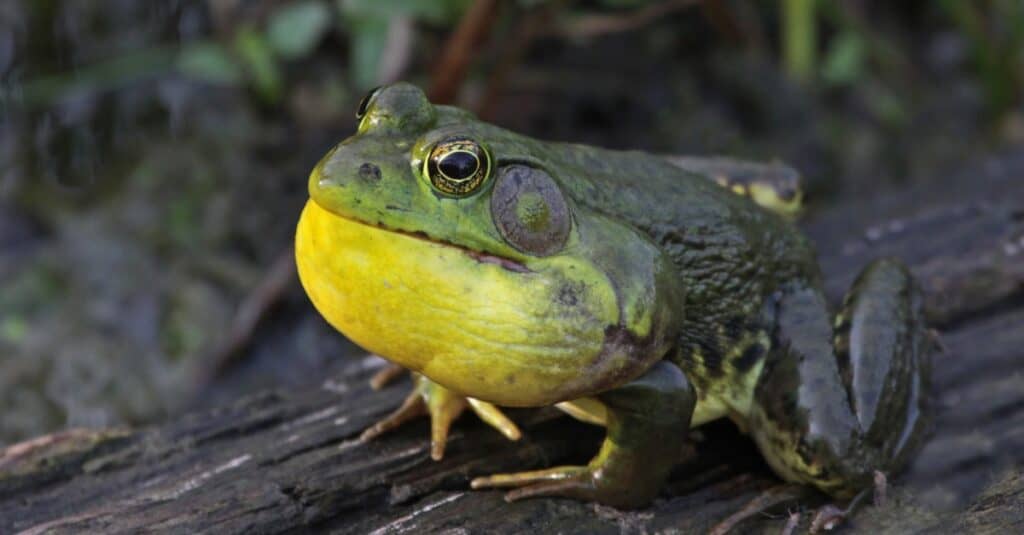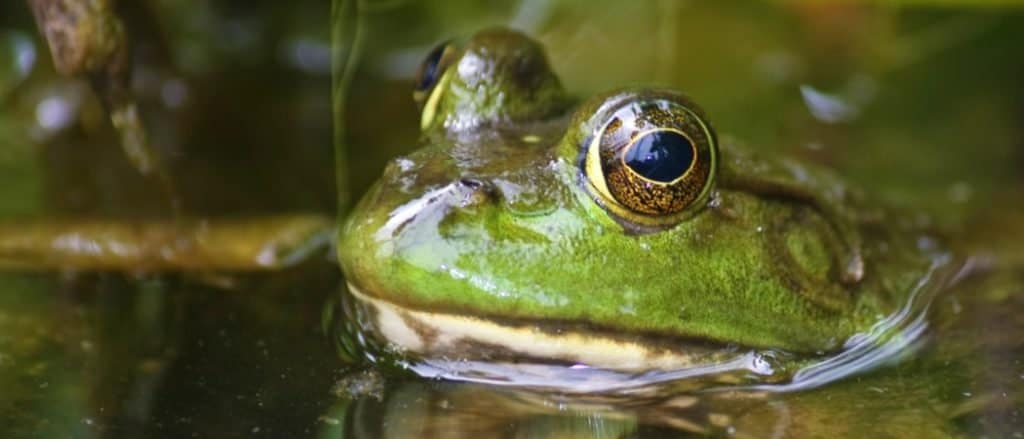Although the term “bullfrog” is often given to any large frog, regardless of species, there are quite a few species of bullfrogs, with the best known being the American and African bullfrogs. Bullfrogs are found in freshwater habitats such as ponds, lakes, and marshes around the world. Being generally larger than most other frogs, bullfrogs tend to have a more voracious appetite and eat a wide range of prey – including rodents, reptiles, birds, and fish. Considering their diet, they must have some pretty serious teeth, right? Wrong! In fact, their teeth are nothing at all like you would expect, and even prehistoric frogs had fascinating teeth too. Join us as we discover everything you need to know about bullfrog teeth
Bullfrog Teeth

Bullfrogs are carnivores and eat anything they can catch, but they don’t use their teeth for chewing.
©iStock.com/ca2hill
Although bullfrogs are usually carnivores, they don’t have the sort of teeth that you would expect them to have. This is because they don’t have the traditional sort of teeth that most other animals have. Most other animals – humans included – have teeth that are made from tough enamel, dentin, and cementum and are deeply rooted in the jaw. Bullfrogs teeth aren’t anything like those. Instead, most bullfrogs have two types of teeth – maxillary and vomerine teeth. However, the African Bullfrog is an exception, but we’ll get to that later.
Bullfrogs don’t have to worry about needing their teeth to last for their entire lifetime as they continually replace their teeth whenever needed. This is because there is always a replacement tooth waiting to replace the tooth that is shed. This constant loss and replacement occurs throughout the bullfrogs entire life.
Maxillary Teeth

Bullfrog teeth are virtually impossible to spot
©iStock.com/Sinhyu
Bullfrogs maxillary teeth are located on the upper jaw but are absolutely tiny. Even with their mouths open, it can be really difficult to spot these minuscule teeth. Unlike many other animals which have teeth that are different shapes and sizes, and have different functions, bullfrogs teeth are all virtually the same size and shape. Bullfrogs maxillary teeth are all conical in shape and are located in a row around the outer perimeter of the upper jaw.
Although you might expect these tiny teeth to be used for chewing food, bullfrogs maxillary teeth are actually not used for chewing prey at all. Instead, they are used to maneuvre the prey in their mouth and hold it steady while they swallow it. This is because frogs use their tongue to catch their prey and flick it into their mouths before swallowing it whole – they don’t chew their prey at all.
Vomerine Teeth
If you think that maxillary teeth are difficult to see, then vomerine teeth are virtually impossible to spot. One of the reasons that they are so difficult to spot is that they are partially covered by a mucous membrane. Vomerine teeth get their name from where they are located. Vomerine teeth are found on the vomer bone on the skull which makes up part of the nasal region. This means that they are found in the roof of the mouth. Vomerine teeth are sharp and pointed and are usually found in clusters of two.
Just like the maxillary teeth, vomerine teeth aren’t actually used for chewing food. Instead, they are used for simply helping bullfrogs to swallow it. These tiny, pointy teeth dig into the prey and prevent them from fleeing before it is swallowed.
African Bullfrog

African Bullfrogs have three bony projections on their lower jaw
©Stu Porter/Shutterstock.com
There’s always an exception, and in the case of teeth, it is the African Bullfrog. African Bullfrogs are amongst the largest frogs in the world and have different teeth again. Their maxillary teeth are sharp and curved, but their main feature is their lower teeth. Known as “odontoids”, African bullfrogs have bony projections on their lower jaw. They have three of these projections – large ones at each side and very small one in the center. Although they are not true teeth (which are made from dentin, enamel, and cementum), these odontoids are extremely sharp and can grow to look like fangs in the biggest bullfrogs.
Tadpole Teeth
Even more surprising than bullfrogs not having the kind of teeth you would expect is that tadpoles actually do have teeth! A tadpoles mouth is known as an oral disc. Although tadpoles don’t have teeth when they hatch, teeth begin to form after around four weeks. Depending on the species, tadpoles have between one and eight rows of tiny teeth. Their minuscule teeth help them to “graze” on algae and other organisms such as insects. Eventually, the tadpole begins to morph into a frog and their tadpole teeth disappear and change into their adult teeth.
Frogs Lost their Teeth Millions of Years Ago

Frogs had a full set of teeth millions of years ago
©Tau5/Shutterstock.com
You might have realized by now that frogs are a bit of an oddball when it comes to teeth, and ancient frogs were no different. Incredibly, frogs actually used to have teeth several millions of years ago – around 250 million years in fact! Prehistoric frogs used to have teeth on their mandible (lower jaw) as well as their upper jaw but lost them over the course of evolution. Not only that, but it’s believed that they actually lost them twenty times!
Research has shown that ancient frogs had a full set of teeth and were keen predators. The teeth of early frogs included large fangs and thousands of small teeth which covered the roof of their mouth. These teeth weren’t just the bony projections that the frogs we see today have, but were true teeth. They were tiny but were hook-shaped and pointed backwards – making them ideal for sinking into prey. Combined with the large fangs, these teeth made early frogs extremely menacing indeed. However, just like modern frogs, the teeth of prehistoric frogs were shed and replaced every few months. This means early frogs weren’t too dissimilar to those we know now.
Incredibly, despite frogs having lost their bottom teeth so long ago, one frog – Guenther’s marsupial frog – has managed to buck the trend and is proving to be an anomaly in the evolution record. This is because they have teeth on both their upper and lower jaw. However, they didn’t regain them until 20 million years ago. So far, scientists have been baffled by these frogs as – according to Dollo’s Law of Irreversibility – they shouldn’t have been able to regain their lost teeth.
The photo featured at the top of this post is © Stu Porter/Shutterstock.com
Thank you for reading! Have some feedback for us? Contact the AZ Animals editorial team.







